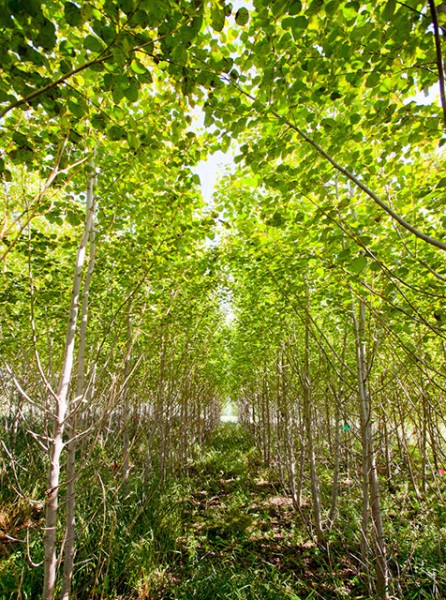Genetics of Wood Formation

Image courtesy of the Great Lakes Bioenergy Research Center via a Creative Commons License To better understand the complex processes involved in wood formation, researchers have developed a new method to study genetic regulatory mechanisms in poplar, a potential bioenergy feedstock (shown here).
The Science
To begin to understand the complex genetic interactions that control poplar growth, a potential bioenergy crop, researchers developed a robust high-throughput pipeline for studying the hierarchy of genetic regulation of wood formation using tissue-specific single cells known as protoplasts.
The Impact
This approach will be particularly useful in studying complex processes in plant species that lack mutants and stable transformation systems. It also can be used to improve forest tree productivity with more precise genetic approaches.
Summary
Wood is an important renewable material for bioenergy and other industrial products, but its formation, a complex process regulated at many levels, is poorly understood. Such processes often involve interactions between regulatory genes known as transcription factors (TFs) and their direct DNA targets. These TF-DNA interactions constitute a regulatory hierarchy.
The new method for isolating protoplasts from the wood-forming stem differentiating xylem tissues of poplar was developed by researchers at North Carolina State University with funding from the U.S. Department of Energy Genomic Science program. The team used the method to study the expression of a specific poplar TF affecting wood formation.
By integrating this novel system with computational approaches, a hierarchical layer of genes was inferred that was functionally validated in the wood-forming stem differentiating xylem. The new approach aids understanding hierarchical gene regulatory networks directed by TFs in poplar and other plant species where mutants are not available.
Funding
This work was supported by the Office of Biological and Environmental Research within the U.S. Department of Energy’s Office of Science under grant DE-SC000691. Authors also acknowledge support of the North Carolina State University Jordan Family Distinguished Professor Endowment.
Publication
Y.C. Lin, W. Li, Y.H. Sun, S. Kumari, H. Wei, Q. Li, S. Tunlaya-Anukit, R.R. Sederoff, V.L. Chiang, “SND1 transcription factor–directed quantitative functional hierarchical genetic regulatory network in wood formation in Populus trichocarpa.” Plant Cell 25, 4324-4341 (2013). [DOI: 10.1105/tpc.113.117697]
Media Contact
All latest news from the category: Life Sciences and Chemistry
Articles and reports from the Life Sciences and chemistry area deal with applied and basic research into modern biology, chemistry and human medicine.
Valuable information can be found on a range of life sciences fields including bacteriology, biochemistry, bionics, bioinformatics, biophysics, biotechnology, genetics, geobotany, human biology, marine biology, microbiology, molecular biology, cellular biology, zoology, bioinorganic chemistry, microchemistry and environmental chemistry.
Newest articles

Properties of new materials for microchips
… can now be measured well. Reseachers of Delft University of Technology demonstrated measuring performance properties of ultrathin silicon membranes. Making ever smaller and more powerful chips requires new ultrathin…

Floating solar’s potential
… to support sustainable development by addressing climate, water, and energy goals holistically. A new study published this week in Nature Energy raises the potential for floating solar photovoltaics (FPV)…

Skyrmions move at record speeds
… a step towards the computing of the future. An international research team led by scientists from the CNRS1 has discovered that the magnetic nanobubbles2 known as skyrmions can be…





















